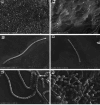The role of the protective shield against UV-C radiation and its molecular interactions in Nostoc species (Cyanobacteria)
- PMID: 39164328
- PMCID: PMC11336245
- DOI: 10.1038/s41598-024-70002-8
The role of the protective shield against UV-C radiation and its molecular interactions in Nostoc species (Cyanobacteria)
Abstract
Cyanobacteria possess special defense mechanisms to protect themselves against ultraviolet (UV) radiation. This study combines experimental and computational methods to identify the role of protective strategies in Nostoc species against UV-C radiation. To achieve this goal, various species of the genus Nostoc from diverse natural habitats in Iran were exposed to artificial UV-C radiation. The results indicated that UV-C treatment significantly reduced the photosynthetic pigments while simultaneously increasing the activity of antioxidant enzymes. Notably, N. sphaericum ISB97 and Nostoc sp. ISB99, the brown Nostoc species isolated from habitats with high solar radiations, exhibited greater resistance compared to the green-colored species. Additionally, an increase in scytonemin content occurred with a high expression of key genes associated with its synthesis (scyF and scyD) during the later stages of UV-C exposure in these species. The molecular docking of scytonemin with lipopolysaccharides of the cyanobacteria that mainly cover the extracellular matrix revealed the top/side positioning of scytonemin on the glycans of these lipopolysaccharides to form a UV-protective shield. These findings pave the way for exploring the molecular effects of scytonemin in forming the UV protection shield in cyanobacteria, an aspect that has been ambiguous until now.
Keywords: Nostoc; Extracellular polysaccharide; Lipopolysaccharides; Molecular docking; Scytonemin; UV radiation.
© 2024. The Author(s).
Conflict of interest statement
The authors declare no competing interests.
Figures








References
-
- Komárek, J. Süßwasserfora von Mitteleuropa. Cyanoprokaryota: 3 Teil/Part 3: Heterocystous genera (Springer, 2013).
-
- Pathak, J. et al. Genetic regulation of scytonemin and mycosporine-like amino acids (MAAs) biosynthesis in cyanobacteria. Plant Gene.17, 100172 (2019). 10.1016/j.plgene.2019.100172 - DOI
MeSH terms
Substances
LinkOut - more resources
Full Text Sources

